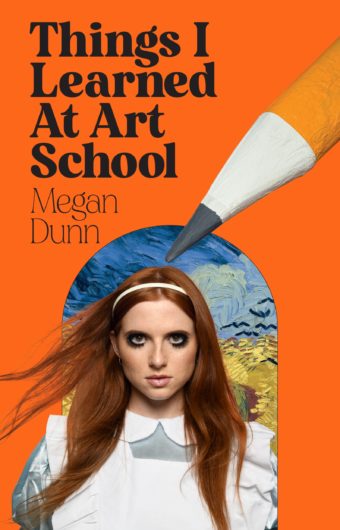‘Twas not brillig’, Megan Dunn writes of her first year at the Elam School of Fine Arts. ‘Slithy toves’ gyred and gimbled; ‘All mimsy were the part-time art school tutors’.
What did she learn?
Postmodernism, post-postmodernism, the male gaze. Something about Walter Benjamin, something about Susan Sontag, everything about subtext. This was 1994. Young British Artist stars Damien Hirst and Tracey Emin were staging a take-no-prisoners conceptual insurrection; Jeff Koons was stalking the American dream ‘like the BFG of contemporary art’.
What didn’t she learn?
Technique. Construction (if you wanted to know how to make anything, you ask a technician). Picasso? ‘Inflated, a Taschen cover, a postcard on the rack. Art was about the now, and in the nineties the now was postmodern.’
Dunn gravitates to the editing suite, cutting and splicing old movies to make short video montages. Some work, others don’t. Her reconfiguration of the 1984 film Splash with Daryl Hannah as the mermaid (mermaids gyre and gimble throughout this book) does not impress her tutors. Her decision to hire a stripper to jump out of a tiered cake at Live at Elam impresses them even less: ‘The famous male gaze we had learned so much about at art school was absent or at least averted’.
Things I Learned At Art School is a rich, rewarding, funny and poignant memoir written as a series of essays beginning from early childhood and ending in the ICU ward with her mother in 2019. Some have been published previously (explaining the occasional repeated reference). Some leapfrog over years of her life; most cluster around her time at art school and immediately after.
The early years read like a John Irving novel. After her parents’ break-up, she and her mother move to the large brick presbytery in Huntly where her grandparents keep house for the priest. It is quiet; the only sound seems to be the click of coins in the collection box. On State Highway 1 ‘the skins of hedgehogs wear the tracks of worn tyres’. Western Barbie is a faithful and necessary companion.
Then to a flat in Henderson, a print of Picasso’s Mother and Child by the Sea in the living room, an Olivia Newton-John poster above the bed, night coming on ‘like a bruise’. Barbie, Strawberry Shortcake dolls, My Little Ponies are clutched tighter.
Then, at 14, a granny flat above the Kawaha Point Manor, Residence for the Elderly, where her mother works as a night nurse and old people sit in the lounge, ‘scattered around the furniture like cushions’.
The writing shifts and sharpens. The veneer of nonchalance is sliced through with painful memories and haunting imagery. Her mother runs down the driveway after a musician with a HOT2GO licence plate; her uncle kills himself — ‘instead of Miss Scarlett, with the spanner, in the library: Patrick MacGill, with the car, in the garage’. At high school, the promise of love drawn from the Sweet Valley High books is undercut by the reality of vicious bullying. The steamy intimations of sex in Jean M. Auel’s Earth’s Children series are deflated when her schoolfriend disappears into the bedroom with an older man: ‘I sat in the lounge, looking at the fruit in the bowl.’
Then university, art school. Vintage clothes, cask wine, a new artist-run space, more cask wine, irony by the bromide bucketful.
‘Rather than freeing me and releasing me into the slipstream of my ideas and giving me the technical skills to ride the current, art school changed what I thought was relevant.’
Relevance is determined by subtext, criticality, a re-levelling of the academic canon signposted here by quotes from Wikipedia, entries on Goodreads and out-takes from old movies. Any remaining Irving overtones morph into a Chris Kraus lesson in social survival.
Naomi Wolf’s The Beauty Myth — ‘Never read it, think I’ve got the gist.’ The Sweet Valley High franchise — it had as much light to shed on civilisation, she believed, ‘as the secrets of King Tut.’
Like her childhood defence force of Barbie dolls and little ponies, Dunn’s exposure to art is a catalogue of reproduced images: Cezanne, Picasso, Van Gogh’s Sunflowers above the kitchen table ‘full of a crooked vigour’. Three koi carp swish their orange tails in a calligraphic painting at the Belle de Jour massage parlour where she works as a bartender/receptionist after leaving art school (‘I was an artist in search of good material and I thought working at the Belle de Jour would add a certain je ne sais quoi to my autobiography,’ she writes).
On the eighth floor of Auckland Hospital, a Claudia Pond Eyley print and a multi-panel painting of a New Zealand landscape line the walls of the intensive care unit. This is nearly two decades after Dunn left New Zealand for the UK. Her mother is dying. Grief crowds in. Dunn’s descriptions are heartbreakingly gentle, revealing a writer completely in charge of her art form.
By this time her career has taken a different path. The book largely skips over the ten years she spent in London. She reads, she takes a job in a bookshop, she completes a Master’s in Creative Writing at the University of East Anglia. ‘Bite by bite. I was not just a submerging artist. I was a writer.’
This review was originally published on the Academy of NZ Literature site.



